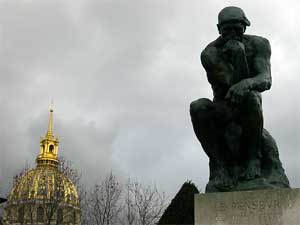 |
| Rodin's famous statue of The Thinker in Paris. |
What is the connection between thinking and writing? How can instructors articulate this connection to engage students in the thinking and writing processes in their discipline?
These questions were the focus of last monthÕs Dalhousie Conference on University Teaching and Learning. More than 120 professors, educational developers, and graduate students came together to discuss the contribution of critical thinking and writing to a university education, no matter what the discipline.
Sunny Marche, Assistant Dean of Graduate Studies, said almost every intimate human experience is documented to be viewed by others Ñ with the notable exception being thinking and writing. This gap was addressed by conference participants who examined their own thinking and writing processes.
Participants engaged in extensive discussion about how we might make the most of students' time in and outside of the classroom through the use of activities that promote their critical thinking and provide graded and un-graded opportunities to write in a variety of ways. Workshops were described by participants as: Òdeep,” Òchallenging,” Òthought-provoking,” Òinformative,” Òinteresting,” Òlively,” Òinteractive,” full of Òwonderful ideas” and Òentirely worthwhile.”
ÒEvery invitation to write is an opportunity to think, reflect, and learn,” said keynote speaker Anthony Pare, professor in McGill UniversityÕs Department of Integrated Studies in Education. Instructors need to provide many opportunities for students to write, arguing that writing stimulates learning through trial and error, he said. Students should understand the possible forms of the finished product, and that their writing (and of course their thinking) can make things happen Ð it has a Òsocial force.” One participant left the plenary with the message that Òencouraging writing can be fun!”
On the second-day of the conference, a plenary session entitled ÒOf course I teach for critical thinking” was facilitated by Geraldine Van Gyn, from the University of VictoriaÕs Faculty of Education and Kinesiology. She began by asking participants to define Òcritical thinking” and to share and comment on each othersÕ definitions.
Audience members believed this was a worthwhile exercise allowing for a Òrethink of the whole idea and concept of critical thinking.” From a student perspective, her collaborative research showed that many students believe that they do not get opportunities to think critically. Students also identified ways instructors could make room for critical thinking by: making time for questions and discussion, asking good questions, providing complex and relevant problems, giving clear guidelines, talking about their own research, providing good examples, creating interesting assignments, and providing comprehensive feedback.
In the closing plenary, Susan Drain, professor of English at Mount Saint Vincent University, gave a dynamic presentation that drew on both her own disciplinary critical thinking and the TV show House, to illustrate that there can be formulas for our thinking. In part this is because our thinking processes are also influenced by the broader world in which our ideas are situated. While we need to be aware of our thinking and writing patterns and share them with our students, we also need to convey the importance of being open to new directions and innovative and idiosyncratic ways of thinking and writing. Participants commented on her Òbeautifully crafted presentation” that was Òclearly meant to engage us and to make us think” Ñ food for thought.
The Centre for Learning and Teaching extends sincere thanks to all the presenters and participants involved in making the conference a great success and to particularly note the support of the Vice-President AcademicÕs Office in supporting the contributions of exceptional keynote speakers to the conference.
 | Suzanne Le-May Sheffield, Ph.D., is the Associate Director (Programs) at Dalhousie's Centre for Learning and Teaching. |
